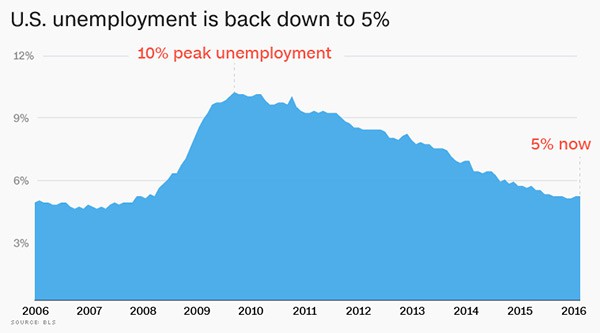
The Fed has achieved one of its two goals – full employment.
So says John Williams, president of the San Francisco Federal Reserve. He reported that the U.S. economy is back on track and we’re basically at full employment, signaling an end to America’s job crisis.
And as the economy improves, signs are pointing to continued good news throughout the rest of the year. Among them, the strength of retail sales; manufacturing, factory and industrial output; home building; and an increase in discretionary spending.
Two home improvement giants – Home Depot and Lowes – both reported strong first quarters in 2016, as the investment value in home ownership rises. “We’re seeing continued improvement in the job market, we’re seeing continual improvement in wages, we’re seeing continued improvement in home values. It’s driving continued improvement in their intentions for discretionary spending,” Lowe’s CEO Robert Niblock said in a recent Quartz article.
The evidence is clear given we’ve had one of the healthiest labor markets in decades over the last few months. The number of workers applying for new unemployment benefits reached its lowest level since late 1973, and jobless claims maintained the longest streak below 300,000 since the early 70’s as well. “The fact that the numbers continue to ratchet down suggests that labor demand is strong and a sign the labor market should continue to improve,” Chief Economist Timothy Hopper of TIAA Global Asset Management shared in a recent Wall Street Journal article.
Although wages are rising more slowly than previous economic recoveries, the steadying of unemployment at 5% has increased wage growth as employers boost salaries to retain talent. ADP’s Workforce Vitality Report for Q1 reported that full-time workers in finance and real estate saw an average 5.3% increase in wages, up 1% from the year prior, while those switching jobs in the same category saw a 6.7% increase in wages.
Bloomberg BNA said the rate of wage growth for most workers in the U.S. will likely continue to increase in the second half of the year. Kathryn Kobe, an economist who works with Bloomberg BNA, said she expects the rate to improve between 2.5 and 3% through the rest of the year. Wages previously increased from 3.3 to 3.6% pre-recession.
“This may be a signal that continued employment growth is leading to a smaller pool of available talent, in turn motivating employers to increase wages to retain experienced workers,” Ahu Yildirmaz, head of the ADP Research Institute, said.
The increase in competitive wages, coupled with the highest rate of employee confidence in 7 years, means workers are gaining leverage. And while businesses still plan to hire staff throughout the year, finding the right talent has once again become as the main concern – and the main challenge to company growth – for the first time since the pre-recession economy, especially given the increase in retirements and entry level candidates without the necessary skills.